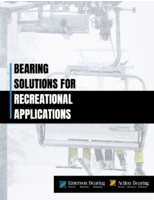Tube Fittings withstand pressures up to 20,000 psi.
Share:
Press Release Summary:
Phastite tube fittings employ compression assembly principle that utilizes toothed profile to make seal. To assemble joint, user inserts tube, and then uses handheld hydraulic tool to push collar along fitting body until it reaches dead stop. Phastite fittings are available in straight union, union elbow, tee, and union cross fitting shapes in imperial and metric sizes from ¼ to ½ in. or 6 to 12 mm.
Original Press Release:
Innovative 'Push-Fit' High-Performance Tube Fitting Offers Huge Cost Savings to Industrial Gas and Liquid System Builders
* can replace expensive-to-install cone-and-thread or welded fittings for applications to 20,000 PSI
Huntsville, AL, September 5, 2006 --- Parker Instrumentation announces a radical new design of tube fitting that can deliver huge cost savings to builders of industrial equipment involving fluids.
Assembled by means of a simple push-fit operation, the new fittings provide permanent connections for fluid systems operating at up to 20,000 PSI / 1,379 bar. For permanent connections, and these elevated pressures, system builders would typically use either welded or 'cone and thread' style fittings, which are time consuming and expensive to install. Compared with these products, Parker Instrumentation estimates that its new Phastite fittings could reduce installation costs by a factor of 90% or more.
"There has been little significant change in industrial tube fitting design for 50 years," notes Parker Instrumentation's Steve Mullen. "By starting with a blank sheet, and re-thinking the sealing principle, we have devised a fitting that radically changes the economics of fluid system building - providing the prospect of major cost savings for millions of industrial companies worldwide."
Phastite employs a compression assembly principle using a novel form of toothed profile, which makes the seal. The fittings are supplied as one-piece components. To make a joint, all that's required is to insert the tube, and then push the collar along the fitting body until it reaches a dead stop. This operation is performed by a simple handheld hydraulic tool, and takes a few seconds. The tool requires no skill to use, and assures users of right-first-time connections.
This assembly approach contrasts with the requirement to perform a 360-degree weld around the circumference of a tube, an operation requiring skill, consumables, expensive equipment, and up to 10 minutes of time. Or, the coning and threading of a tube end to prepare it for use in a special screw-together fitting, operations that again require skill, and time - in this case up to 30 minutes or more. For many applications, the quality of the weld is also tested by means of dye penetration, or x-ray inspection, adding further substantial costs to the installation process.
Inside Phastite fittings is a unique sealing system, based on a collar which slides along an angled body, in the process compressing a number of circular profiles into the tubing. At the end of the short travel is a vertical face which provides confirmation of correct assembly.
Phastite is much faster to assemble than welded and cone and thread fittings, but also deskills the process, removing a major element of industrial system building cost. The very high degree control over make up that the tooling automatically imposes also assures users of right-first-time assembly. This is not the case with welded and cone and thread fittings, where many users expect that there will a certain degree of rework. When used to replace a welded fitting, the Phastite fitting also eliminates any need for a 'hot work permit', another major equipment building expense faced by many organizations.
The 20,000 PSI (1,379 bar) pressure rating of Phastite opens up an extremely large potential marketplace. Welded, and cone-and-thread, style tube fittings are used in industrial applications where there are pressures above those that can be handled by ferrule types - which is broadly speaking above 6,000 PSI / 413 bar. Applications include high pressure hydraulics, deepwater oil and gas drilling, ROVs and subsea, laboratory testing, and high pressure machinery such as water-jet cutters. Welded fittings are additionally used in lower pressure applications if there is a need for the 'peace of mind' that comes from a permanent connection, or where a leak could have serious consequences. Examples include subsea applications, aerospace, boat building and military equipment, and plants that are remote or unmanned, or have safety implications such as nuclear materials.
The Phastite range includes straight union, union elbow, 'tee' and union cross fitting shapes in imperial and metric sizes from ¼ to ½ inch or 6 to 12 mm. There is also a range of termination connectors that provide a link between the equipment's fixed, permanent tubing, and any element that needs to be disconnected or maintained.
The assembly tool is an important part of the package, and Parker Instrumentation has developed a novel hydraulic tool that is similar in size to a soft drink can, and which features a flat working edge that can install tubing in confined spaces such as against a panel. The small pump that drives the tool is available in a shoulder-carried version, providing great flexibility of movement for operators. The cost of the tool is equivalent or less than the equipment required for welding, or coning and threading. Phastite fittings and tools are available for order from October 2006.
Parker Instrumentation Products Division, 1005 A Cleaner Way, Huntsville, Alabama 35805-6708, USA. Tel: 256 881-2040; ipdsales@parker.com




